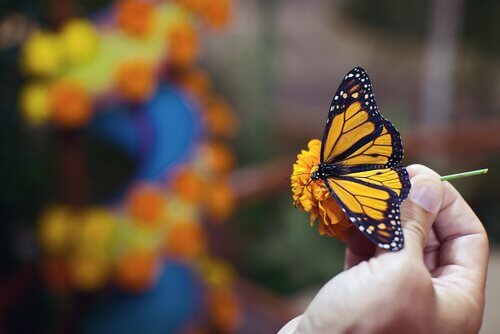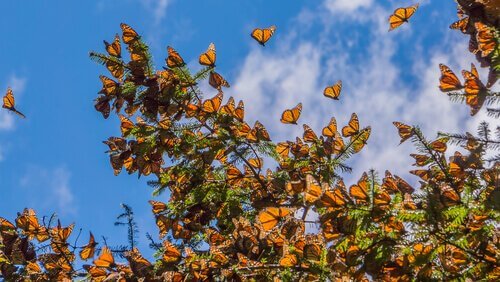The Incredible Odyssey of Monarch Butterflies

Monarch butterflies are one of the best-known butterfly species in the world. This is because of its characteristic orange color and its long annual migration route. This insect lives in almost all of America, from Canada to the northern part of South America.
Monarch butterflies’ colors
Adult monarch butterflies (Danaus archippus) are very brightly colored. The outer part of their wings is orange, interlaced with black lines. In contrast, the inner part of the wings is an opaque orange.
This color distinction helps monarch butterflies survive. Due to its opacity, the inner part of their wings helps them to camouflage themselves with tree bark and other surfaces. The outer part, which is much more eye-catching, works as a visual warning for predators since these butterflies are poisonous when consumed.
This type of warning towards predators is known as aposematism, or a warning coloration. It’s an evolutionary strategy, since most predators associate bright colors, like orange and yellow, with poison.
Monarch butterflies contain cardiac glycosides inside their bodies, a substance that’s poisonous to some animals. The butterflies acquire this property by feeding on milkweed plants when they’re still caterpillars. However, there are some species of birds and rodents that are immune to this kind of poison.

Life cycle of monarch butterflies
Monarch butterflies can measure between 8 and 10 centimeters and it’s very easy to recognize the distinction between males and females. Males are a little larger and have a black spot on the back center of each wing. Adults weigh approximately half a gram.
Monarch butterflies go through four major stages:
1. Everything begins when eggs are laid on plants from the Asclepias genus, better known as milkweeds. The eggs aren’t even two millimeters big and they will hatch after four to eight days.
2. Larvae emerge from the eggs, feeding on the same leaf where their mother laid them. Eventually, they will turn into robust caterpillars with a yellow, black and white striped pattern on their whole body. They’ll stay in this caterpillar stage for about two weeks depending on the amount of food they eat.
3. Once they’ve fed themselves enough, the caterpillars prepare to make their chrysalis, which will allow them to begin their process of metamorphosis. The chrysalis is lime green, with golden spots and a black band. This process lasts for 10 days.
4. At the end of the transformation, a monarch butterfly will emerge from the chrysalis. Its estimated life span will depend on when it was born. Those who are born early in spring and summer will live between two and three weeks. However, those who are born at the end of the summer and the beginning of fall can live up to eight months. These are the monarch butterflies that will make the great odyssey: the massive migration from Canada to Mexico, and back.
Monarch butterflies’ massive migration
The North American monarch butterflies that are born at the end of summer are the ones that make the massive migration from Canada to Central Mexico or California. The distance exceeds 5,000 kilometers, and they do this to escape the winter. Each fall they begin their journey and then they return in the spring.

There are two big migratory routes for monarch butterflies. The most well known goes from the south of Canada to the center of Mexico, to the state of Michoacán. The other route goes from the south of Canada to the coast of California in the United States. 90% of monarch butterflies born in Canada take the first route, while the remaining 10% take the second one.
The incredible odyssey
To guide themselves, monarch butterflies use the sun’s position and the intensity of the sunlight. However, it’s a total mystery how this biological compass works since we don’t know how butterflies process light through their eyes. This is one of the great mysteries of how monarch butterflies carry out their massive migration every year in search of warmer places.
Although North American monarch butterflies are the most famous, they also exist in other parts of the world. For example, all of northern South America (Venezuela and Colombia) and southern Florida. Additionally, they have recently been introduced to Australia, New Zealand, Hawaii and Spain.
Monarch butterflies are currently considered a threatened species. This is because the group that makes the mass migration each year is increasingly being reduced. There are many reasons for this reduction and human beings are the main factor.
Lack of milkweed plants as a result of deforestation is a factor that directly impacts them. On top of that, in recent decades we have seen that using herbicides in agricultural fields has also decreased their population.
All cited sources were thoroughly reviewed by our team to ensure their quality, reliability, currency, and validity. The bibliography of this article was considered reliable and of academic or scientific accuracy.
- Pyle, Robert Michael (2001). Chasing Monarchs: Migrating with the Butterflies of Passage. Houghton Mifflin Books.
- Brower, Lincoln (1999). Para comprender la migración de la mariposa monarca, 1857-1995. Mexico D.F.: Instituto Nacional de Ecología.
This text is provided for informational purposes only and does not replace consultation with a professional. If in doubt, consult your specialist.